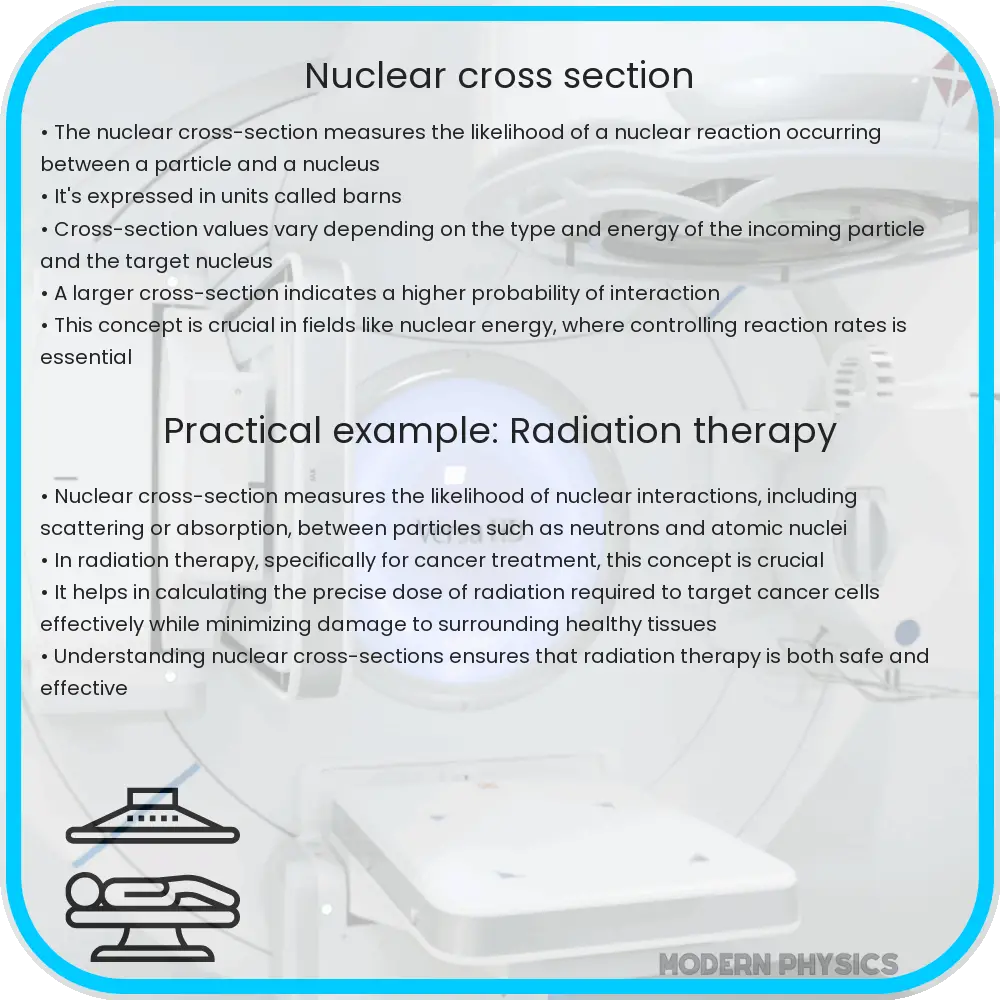The nuclear cross-section measures the probability of nuclear reactions between particles such as neutrons and nuclei, vitally impacting nuclear physics and technology.

Understanding Nuclear Cross-Section
The concept of nuclear cross-section is fundamental in nuclear physics, particularly in the fields of nuclear reactions and nuclear technology. A nuclear cross-section is a measure of the probability of a nuclear reaction occurring between interacting particles, such as neutrons and nuclei. This metric is crucial as it influences calculations in areas ranging from nuclear power generation to medical isotope production and even in astrophysical phenomena.
The Basics of Nuclear Cross-Section
To visualize what a cross-section is, imagine aiming a stream of particles at a target. The cross-section represents the effective area that the target presents to the incoming particles, influencing the likelihood that an interaction will occur. It’s important to note that this ‘area’ is not a physical size but a probability measure and is typically expressed in units called ‘barns’, where 1 barn is equal to 10-28 square meters.
Mathematically, the nuclear cross-section, denoted as σ, helps in calculating the reaction rate, R, using the formula:
where:
- σ (sigma) is the nuclear cross-section for the specific reaction,
- n is the number density of target nuclei,
- φ (phi) is the flux of the incoming particles per unit area.
This equation underscores the direct correlation between the nuclear cross-section and the probability of a nuclear reaction occurring. Higher values of σ indicate a greater likelihood of a reaction.
Types of Nuclear Cross-Sections
There are several specific types of nuclear cross-sections, each relevant to different types of nuclear reactions or interactions. The most commonly discussed types include:
- Total Cross-Section: This measures the total probability of an incoming particle interacting with a target nucleus in any way.
- Elastic Cross-Section: Specific to reactions where the incident and target particle interact without any change in their internal states — essentially, they scatter off one another.
- Inelastic Cross-Section: In contrast to elastic scattering, inelastic interactions involve a change in the internal energy state of the participating particles, often leading to the emission of radiation or smaller particles.
- Capture Cross-Section: Represents the probability of an incident neutron being absorbed by the target nucleus, often leading to a compound nucleus’s formation.
- Fission Cross-Section: Particularly relevant in nuclear power contexts, this is the probability of a reaction that results in the nucleus splitting into two or more smaller nuclei, releasing energy and more neutrons.
Each type of cross-section is key to understanding different aspects of nuclear physics and requires distinct measurement techniques and theoretical models to analyze effectively.
Factors Influencing Nuclear Cross-Sections
The value of a nuclear cross-section can be influenced by several factors, including the energy of the incoming particles and the properties of the target nucleus. Typically, cross-sections vary with the energy of the incident particle, showing peaks (resonances) at certain energies. Understanding these variations is crucial for designing nuclear experiments and reactors, as well as for safety assessments in nuclear technology.
For example, thermal neutrons, which have very low kinetic energy, are more likely to be captured by a nucleus compared to fast neutrons, which have higher energy and are more likely to cause fission. Such knowledge helps in tailoring nuclear reactions for specific outcomes, whether for energy production, medical treatments, or research purposes.
Applications of Nuclear Cross-Sections
Nuclear cross-sections are not just theoretical constructs but have practical applications in many fields:
- Nuclear Power: In nuclear reactors, controlling the fission cross-sections of materials like uranium and plutonium is essential for maintaining a sustained and controlled nuclear chain reaction.
- Medical Applications: In radiation therapy, specific cross-sections are targeted to optimize the destruction of cancerous cells while minimizing damage to healthy tissue.
- Scientific Research: In fields like astrophysics, understanding the cross-sections involved in stellar reactions helps scientists predict star life cycles and element formation in the universe.
Each of these applications relies on precise measurements and control of nuclear cross-sections to achieve desired results efficiently and safely.
Conclusion
The study of nuclear cross-sections is a pillar of nuclear physics, with implications spanning from fundamental science to practical applications in energy, medicine, and research. By quantifying the likelihood of different types of nuclear interactions, scientists and engineers can design more effective systems and technologies. As we continue to explore and harness the power of the atom, the role of nuclear cross-sections in understanding and manipulating nuclear processes remains indispensable. Whether it’s generating power, treating diseases, or uncovering the secrets of the cosmos, the insights gained from nuclear cross-section studies help pave the way for innovative advancements and deeper understanding.
